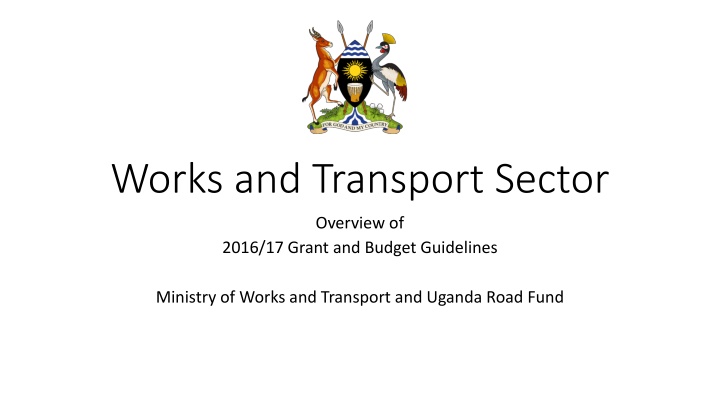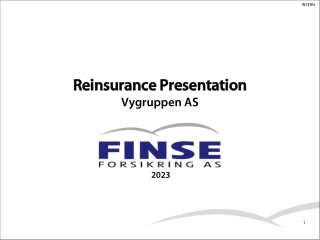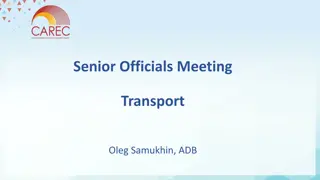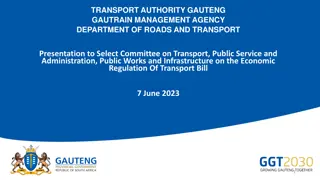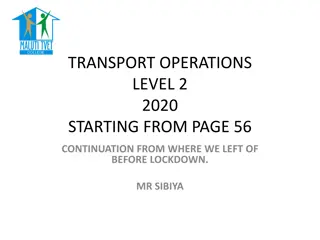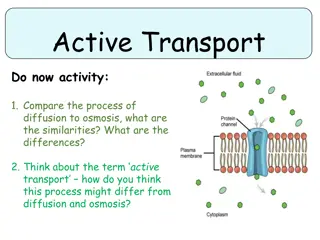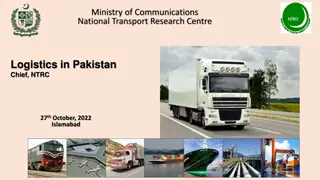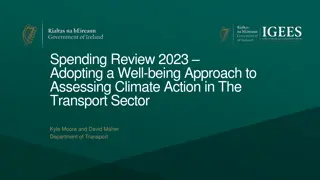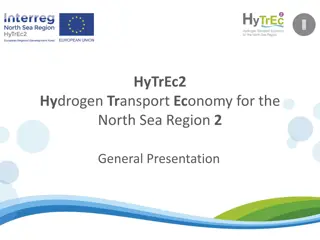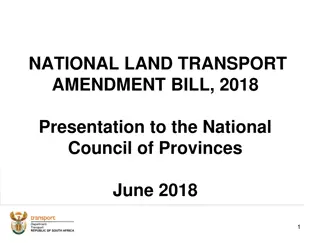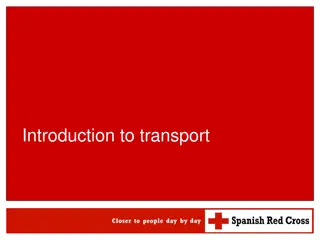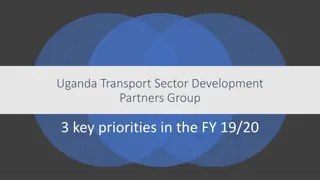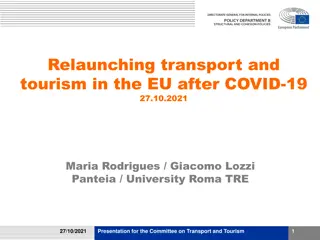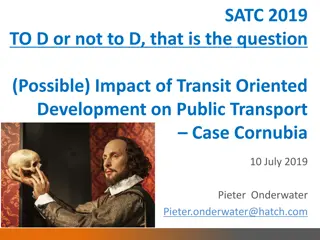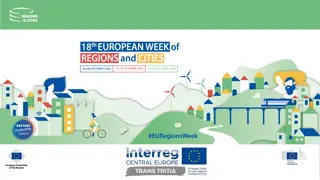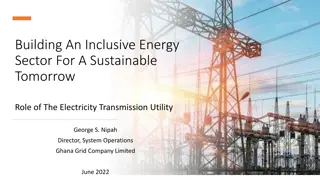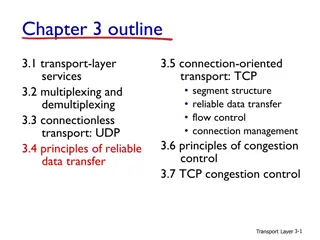Works and Transport Sector Overview 2016/17 Guidelines
This document provides an in-depth overview of the Works and Transport sector, including budget guidelines, policy priorities, sector transfers, allocation formulae, key variables, and budget requirements for 2016/17. It highlights the sector's objectives, priorities, and strategies for improving infrastructure and enhancing competitiveness in Uganda.
Uploaded on Mar 18, 2025 | 0 Views
Download Presentation

Please find below an Image/Link to download the presentation.
The content on the website is provided AS IS for your information and personal use only. It may not be sold, licensed, or shared on other websites without obtaining consent from the author.If you encounter any issues during the download, it is possible that the publisher has removed the file from their server.
You are allowed to download the files provided on this website for personal or commercial use, subject to the condition that they are used lawfully. All files are the property of their respective owners.
The content on the website is provided AS IS for your information and personal use only. It may not be sold, licensed, or shared on other websites without obtaining consent from the author.
E N D
Presentation Transcript
Works and Transport Sector Overview of 2016/17 Grant and Budget Guidelines Ministry of Works and Transport and Uganda Road Fund
Overview 1. Sector Objectives 2. Structure and Purpose of Sector Transfers 3. Allocation Formulae 4. Budget Requirements 5. Service Delivery Units / etc 6. Other Sectoral Issues 2
Sector Policy Priorities NDP II Objective 2: to increase the stock and quality of strategic infrastructure to accelerate the country s competitiveness. Over the medium term: 2,205KM of gravel roads will be upgraded to tarmac 700KM of old paved roads will be rehabilitated 2,500KM of paved roads will be maintained 10,000KMs of unpaved roads will be maintained Priority will be given to opening community access roads to link farmers to markets and improve access to social services. 3
Structure and Purpose of Sector Transfers Grant Non-Wage Conditional Grant (URF) Development Conditional Grant Purpose To conduct maintenance of District, Urban and Community Access Roads To maintain and rehabilitate District, Urban and Community Access Roads N.B. These grants fund the activities of the Local Government Workplan for Roads and Engineering (7a) 4
Key Variables Used in Allocation Formulae The URF allocation for maintenance is made in three stages: 1. Allocation by surface type (paved, gravel, earth) based on vehicle utilisation, road length, asset value and maintenance requirements. 2. Allocation by road network type (national, district, urban, municipal, community) based on vehicle utilisation and economic factors. 3. Allocation by designated authority (Districts, Town Councils, Municipalities, sub counties) based on (i) vehicle utilisation and road length; (ii) equity and climatic factors; and (iii) unit cost factors and population. In addition, Ush15bn is allocated to LGs for mechanical imprest. Ush 10bn for sealing of roads and bridge maintenance. The district development grant allocation remains a flat figure for old and new districts under the RTI Programme. 5
Overview of Budget Requirements Area 1. Narrative and performance contract 2. Overview of Revenues and Expenditure 3. Salaries and Related Costs Requirement The budget narrative summarises information on revenue, expenditure and key outputs in the performance contract. Total Workplan revenues and expenditures balance and are divided correctly between wage, non-wage recurrent, GoU and donor development. Salaries of permanent staff must be within the overall staff and budget ceilings, and funded from the sector conditional wage grant Salary allocations to the Roads and Engineering Department of a local government must be according to the filled posts within the approved structure, recruitment plan and salary scales within a given financial year. As a minimum, the following key positions in the approved structure must be filled: District Engineer, Water Engineer, Engineering Assistant, Road Inspector, Office Attendant, Driver, Office Typist. The Uganda Road Fund (URF) maintenance allocation will be used to fund 6 4. Non-wage
Overview of Budget Requirements (cont) Area 4. Non-wage allocations for road maintenance Requirement The Uganda Road Fund (URF) maintenance allocation will be used to fund maintenance and imprest. All road maintenance will be prioritised using RAMPS and approved by the District Roads Committee. Allocations to each sub-county for road maintenance are on average UGX 7.4m, for removal of bottlenecks on community access roads. Allocations to town councils are on average UGX 120m for routine or periodic maintenance of urban roads and bridges within their jurisdiction, and street lighting. Allocations for maintenance from the URF to higher local governments in the non-wage recurrent budget may only be used for routine or periodic maintenance of district or urban roads and bridges. 5. Roads maintenance by LLGs 6. Roads maintenance by HLGs 7
Overview of Budget Requirements (cont) Area 7. Monitoring and Management Requirement Up to 10% of the non-wage recurrent budget may be allocated for other operations and maintenance, including monitoring activities and provisions for the District Roads Committee. The sector development budget will be used to fund road rehabilitation or construction and may also fund the purchase of vehicles and equipment. In FY2016/17, the sector development grant will be restricted to financing road sealing, unless the local government is provided written exemption. All road rehabilitation and construction will be prioritised using RAMPS and approved by the District Roads Committee. Between 5% and 10% of the development allocations to capital investments will finance investment service costs, such as bills of quantities or economic impact assessments. 8. Capital Investments 8
Other Sectoral Issues URF Funding should be made available for: New Municipalities; New Districts; New Town Councils; Subcounties; Funding should also be made available for the increased operational costs of UNRA. Optional slide to be completed by line ministries 9
